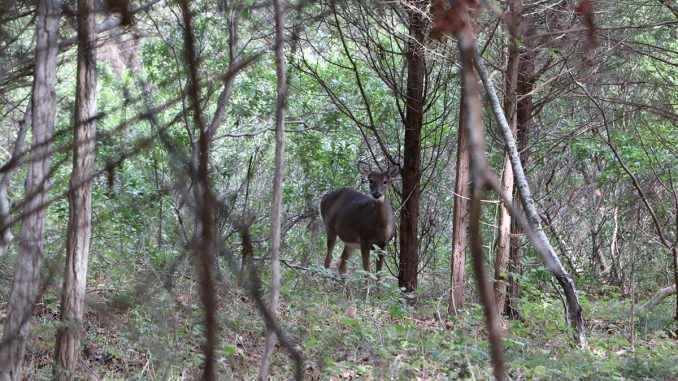
Calling the overpopulation of deer in Southold a worsening crisis, speakers at Saturday’s meeting of the Southold Peconic Civic Association sounded the alarm that measures must be taken immediately to dramatically reduce the numbers.
At the meeting, Southold Town Board member Greg Doroski characterized the “deer and tick problem in town as a public health and environmental crisis. It’s the No. 1 issue facing our community.”
He estimated the size of the white-tailed deer herd in Southold at between 5,000 and 7,000 – thousands more than the area can handle. The huge herd has destroyed the understory in woods, spread tick-borne diseases and destroyed homeowners’ gardens and farmers’ crops.
He reinforced the point by saying that 369 deer killed by cars were taken to the town landfill up through last week. However, Dan Goodwin, Southold’s highway superintendent, said in an interview that the number through Sunday was 483.
“We had two more this morning,” he said Monday.
Estimates by the Riverhead Town Highway Department show a yearly average of deer killed by cars and buried at that town’s landfill is approximately 250, and that is just on town-owned roads.
Both Mr. Doroski and a second speaker at the forum, Arnold Blair, a member of the Deer Management Task Force and the deer committee for the Nassau Point Homeowner’s Association, said dozens more deer hit by cars die in the woods and are not recovered.
By that guess, the yearly number of deer killed by cars in both towns would top more than 1,000. At, say, $4,000 in repair costs per car, the yearly insurance costs in both towns is estimated to be well into the millions.
One person who attended the forum said wildlife biologists’ best guess for a healthy deer population is one per 10 acres of open space. According to the U.S. Census Bureau, Southold contains 53.7 square miles of land. A large portion of that is developed, and much — if not most — of the farmland and vineyards are now fenced in to keep deer out, dramatically reducing open space for deer to feed and gather.
As Mr. Doroski explained, the fencing of large tracts of farmland pushes the deer into residential areas. But even if all 53.7 square miles was undeveloped and not fenced, a healthy deer herd in Southold would be closer to 600 – not the estimated 5,000 to 7,000.
Both Mr. Blair and Mr. Doroski said recreational bow hunting for deer is not enough to reduce the herd, with does each spring giving birth to two to three fawns. Mr. Blair said the Nassau Point Homeowners Association received an nuisance permit from the New York State Department of Environmental Conservation, and has an agreement with a professional hunting organization to cull the deer on the point. He said each spring, however, the numbers go back up again.
Both speakers said a bill expanding hunting options will be reintroduced in the State Legislature in January. Among other proposals on the table in Albany are allowing the use of crossbows, paying a per-deer bounty to encourage more hunting, and legalizing the use of bait and lights so that hunters can go out at night.
Mr. Blair encouraged other communities in Southold to form committees that would then survey homeowners to see who would allow hunters on their property. He said that model has worked on Nassau Point.
“We have one person who manages the herd for us,” he said. “We know all the hunters. They are all locals and it’s safe. There’s never been a problem. The message needs to go out to other parts of town, that we are doing this and so can they.”
More information, including a survey can be found on the town’s website.

